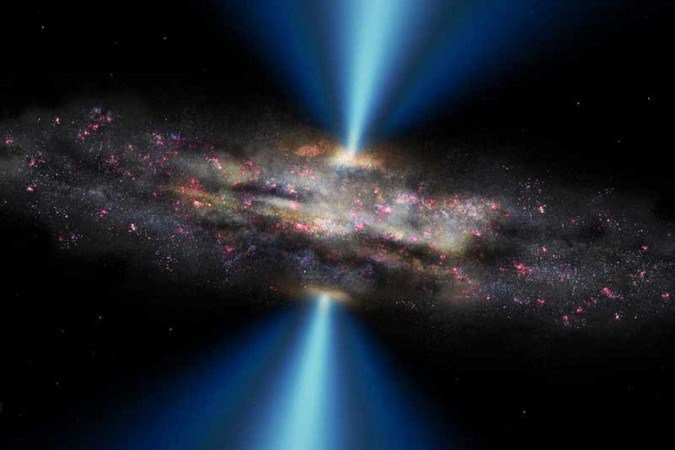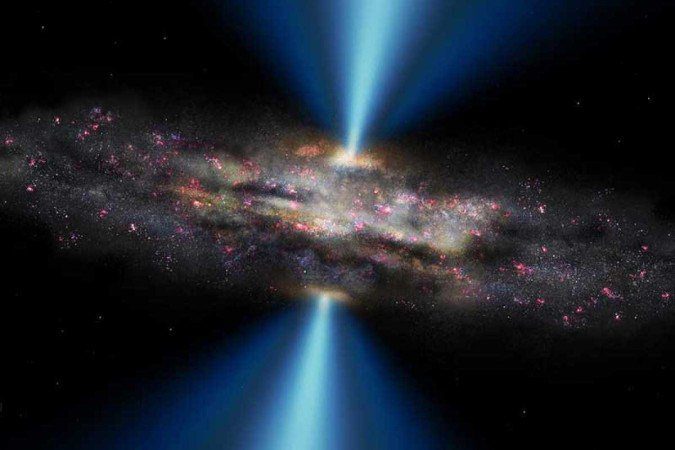Supermassive black holes may have “killed” galaxies in the early universe
3 min read
Published 05/30/2022 20:44

A black hole, called CID-947, was discovered in 2015. According to NASA, it has grown faster than its host galaxy and has a mass about 7 billion times the mass of our Sun, making it among the largest black holes discovered. – (Credit: M. Helfenbein, Yale University/OPAC)
A complex – and harmful – relationship between black holes The supermassive galaxies they inhabit may explain how these intense gravitational field regions are responsible for rendering star systems useless. A study prepared by an international group of astronomers, and published last Friday (27/5), identified active signals from supermassive black holes in “dying” galaxies, that is, that stopped growing and forming stars at the beginning of the universe.
By observing a series of distant galaxies, located 10 billion light-years away, experts realized that the increase in the activity of black holes Super objects in these star systems have many “far-reaching effects on the evolution of the host galaxy”, and one of them is a possible “kill” of these spaces.
The Milky Way, where we live, has stars of different ages, including stars that are still in the process of formation. But in some other galaxies, all the stars are old and about the same age – they are called elliptical galaxies. ” Astrophysical Journal.
“This indicates that early in their history elliptical galaxies experienced a period of abundant star formation that ended abruptly,” they add. Scientists say the disruption of galaxies is not well understood by experts in the field, but the cluster’s discovery may provide an explanation.
“One possibility is that Black hole The study explains that the enormous energy causes gas turbulence in some galaxies, creating an environment unsuitable for star formation.
To arrive at these results, a group led by scientist Kei Ito of the National Astronomical Observatory in Japan used technology provided by the Cosmic Evolution Survey (Cosmos) to combine data obtained from observations of distant galaxies by several satellites, such as the Subaru Telescope and the Atacama Large Millimeter Array. / meter (alma).
They have been observed from galaxies that are between 9.5 billion and 12.5 billion light years from Earth and with telescopes. The distance allows us to observe exactly what the galaxy was like in the early universe. “The light we see from an object 10 billion light years away would have to travel 10 billion years to reach Earth. So the light we see today shows us what a galaxy looked like when the light left that galaxy 10 billion years ago. So looking at distant galaxies is like Looking back in time,” he explains.
The instruments recorded radio waves, infrared light, visible light, and X-ray emissions from these star systems. The report notes that “the team used for the first time optical and infrared data to identify two groups of galaxies: those with ongoing star formation and those in which star formation has stopped.”
The one that stopped is called a dying galaxy – a condition created by astronomers to classify one of these systems as nearly “dead” because no more stars were being produced. The scientists then combined the images with recordings of the galaxies’ signals and noise. The discovery is that X-ray emissions are present most intensely in galaxies without star formation.
The results show that X-rays and radio emissions are too powerful to be explained by stars in the galaxy alone, indicating the presence of an active supermassive black hole. This signal of black hole activity is weaker for galaxies as star formation continues.”
For experts, the study is clear and “shows that the abrupt end of star formation in the early universe is associated with increased activity of supermassive black holes.” Now, they want – and encourage colleagues – to produce new studies detailing the relationship between supermassive black holes and the extinction of galaxies.

“Entrepreneur. Music enthusiast. Lifelong communicator. General coffee aficionado. Internet scholar.”

:strip_icc()/s04.video.glbimg.com/x720/11792055.jpg)

:strip_icc()/s03.video.glbimg.com/x720/11786998.jpg)



